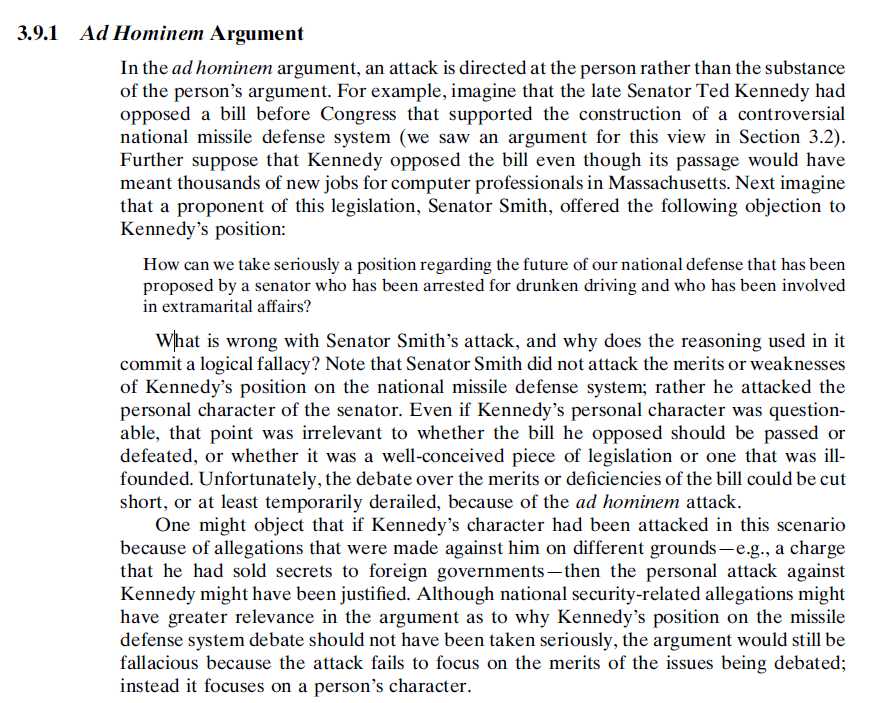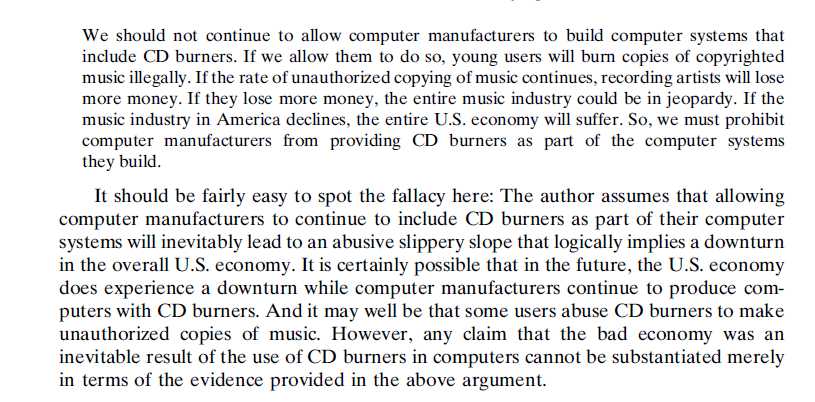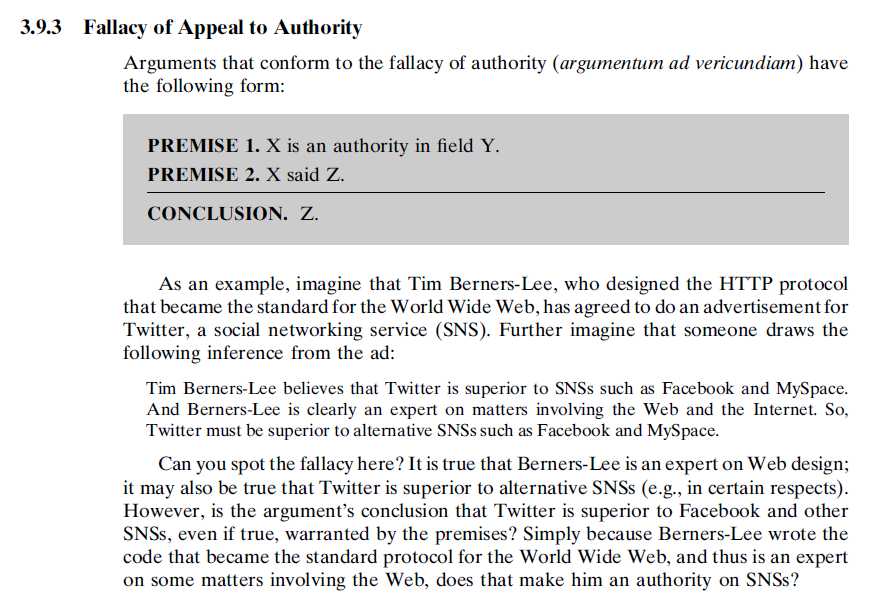标签:mic visio this where must 理解 redirect vol family




3.9.4 False Cause Fallacy
It occurs when the “link between premises and conclusion depends on some imagined causal connection that probably does not exist”. ... This fallacy is guilty of trying to establish a causal connection between two events on dubious grounds.
This a category of informal fallacies in which a cause is incorrectly identified. For example: "Every time I go to sleep, the sun goes down.
当“前提和结论之间的联系依赖于一些可能并不存在的想象的因果联系”时,就会发生这种情况。这个谬误是试图在两个事件之间建立一个可疑的因果关系。
这是一种非正式的谬误,其中原因被错误地确定。例如:“每次我睡觉的时候,太阳都会下山。”
3.9.5 Begging the Question
Begging the question is a fallacy in which a claim is made and accepted to be true, but one must accept the premise to be true for the claim to be true. ... Examples of Begging the Question:
1. Everyone wants the new iPhone because it is the hottest new gadget on the market!
2. God is real because the Bible says so, and the Bible is from God.
3. Killing people is wrong, so the death penalty is wrong.
4. Smoking cigarettes can kill you because cigarettes are deadly.
在这种谬误中,一个断言被提出并被接受为真,但要断言为真,必须接受前提为真。例子:
1.每个人都想要新的iPhone,因为它是市场上最热门的新设备!
2. 神是真实的,因为圣经这样说。
3.杀人是错误的,所以死刑是错误的。
4. 吸烟会害死你,因为香烟是致命的。
3.9.6 Fallacy of Composition / Division
The fallacy of composition arises when an individual assumes something is true of the whole just because it is true of some part of the whole. For example, if you stand up at a concert, you can usually see better. You may then directly infer that if everyone stands up, everyone can see better.
合成谬误:
it is true of some part --》 it is true of the whole
例如,如果你在音乐会上站起来,你通常可以看得更清楚。你推断,如果每个人都站起来,每个人都能看得更清楚。
A fallacy of division is the error in logic that occurs when one reasons that something that is true for a whole must also be true of all or some of its parts.
An example:
1.The second grade in Jefferson elementary eats a lot of ice cream.
2.His house is about half the size of most houses in the neighborhood. Therefore, his doors must all be about 3 1/2 feet high.
3.I heard that the Catholic Church was involved in a sex scandal cover-up. Therefore, my 102-year-old Catholic neighbor, who frequently attends Church, is guilty as well!
分割谬误:
某物对整体是正确 ---》某物对一个或多个部分是正确的。这与合成谬误正好相反。
例子:
1.杰佛逊小学的二年级学生吃很多冰激凌。
2.他的房子大约是附近大多数房子的一半大小。因此,他的门必须都有3.5英尺高。
3.我听说天主教会卷入了一起掩盖性丑闻的事件。因此,我那位经常去教堂的102岁的天主教徒邻居也同样有罪!
3.9.7 Fallacy of Ambiguity / Equivocation
When an unclear phrase with multiple definitions is used within the argument; therefore, does not support the conclusion.
Some will say single words count for the ambiguity fallacy, which is really a specific form of a fallacy known as equivocation.
Example #1:
It is said that we have a good understanding of our universe. Therefore, we know exactly how it began and exactly when.
Explanation: The ambiguity here is what exactly “good understanding” means. The conclusion assumes a much better understanding than is suggested in the premise; therefore, we have the ambiguity fallacy.
Example #2:
All living beings come from other living beings. Therefore, the first forms of life must have come from a living being. That living being is God.
Explanation: This argument is guilty of two cases of ambiguity. First, the first use of the phrase, “come from”, refers to reproduction, whereas the second use refers to origin. The fact that we know quite a bit about reproduction is irrelevant when considering origin. Second, the first use of, “living being”, refers to an empirically verifiable, biological, living organism. The second use of, “living being”, refers to a belief in an immaterial god. As you can see, when a term such as, “living being”, describes a Dodo bird as well as the all-powerful master of the universe, it has very little meaning and certainly is not specific enough to draw logical or reasonable conclusions.
The fallacy of equivocation occurs when a key term or phrase in an argument is used in an ambiguous way, with one meaning in one portion of the argument and then another meaning in another portion of the argument.
Examples:
当在论证中使用具有多个定义的不清楚短语时; 结论无效。
有些人会说,单个单词也算歧义谬论,这实际上是一种被称为Equivocation的谬论。
例1:
据说我们对宇宙有很好的了解。因此,我们确切地知道它是如何开始的以及确切的时间。
Note: 这里的模糊性就是“好的理解”的确切含义。
This fallacy occurs when someone makes an appeal to fear or desire as support for their conclusion. This fallacy is also known as Appeal to Pity, Appeal to Snobbery, and the Bandwagon Argument.
Examples:
1. Everyone says that it‘s okay to lie as long as you don‘t get caught.
2. It might be against the law to drink when you are 18 years old, but everyone does it, so it‘s okay.
3. 75% of the population believes that Hillary Clinton is corrupt, and I just can‘t vote for a liar.
4. There must be some truth to the fact that global warming is a hoax because approximately 25% of the population believes that it is a hoax!
当有人用恐惧或欲望来支持他们的结论时,就会出现这种谬误。这种谬误也被称为诉诸怜悯、诉诸势利和随大流论
例子:
1. 每个人都说谎,只要你不被发现,撒谎是可以的。
2. 18岁喝酒可能是违法的,但每个人都这么做,所以没关系。
3.9.9 Many/Any Fallacy
The many/any fallacy is to conclude that any option is acceptable after observing that many options are acceptable.
For example, you may observe me take several different routes between home and work, and all of them are good in the sense that they allow me to reach my destination safely and in a reasonable amount of time. That does not imply that all possible routes between home and work are good.
许多选项是可接受的 ----》任何选项都是可以接受。
例如,你可能会观察到我在上下班的路上走了好几条不同的路线,它们都很好,因为它们能让我在合理的时间内安全到达目的地。这并不意味着从家到公司的所有可能路线都是好的。
3.9.10 virtuality fallacy
The virtuality fallacy is a name given to the informal fallacy of asserting that a behavior is not real, or does not have real effects, because it occurs in a virtual world such as an online game.[1] The fallacy has the following form:[1]
This fallacy could be used by those who want to defend their own questionable behavior on the Internet by saying "This is not real and will not cause any harm to other people."
这种谬误断言一种行为没有真正的影响,因为它发生在网络游戏这样的虚拟世界中。
有些人会用这种谬论来为自己在网上的行为辩护,他们会说:“这不是真的,不会对他人造成任何伤害。”
Identifying Some Common Fallacies
标签:mic visio this where must 理解 redirect vol family
原文地址:https://www.cnblogs.com/JasperZhao/p/13042120.html